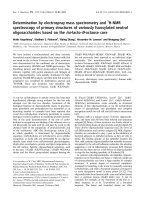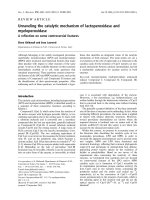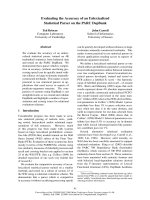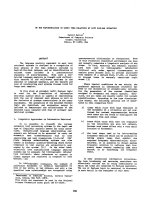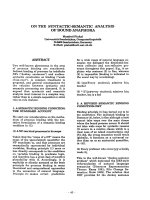Báo cáo khoa học: "ON THE INTONATION OF MONO- AND DI-SYLLABIC WORDS WITHIN THE DISCOURSE FRAMEWORK OF CONVERSATIONAL GAMES ON THE INTONATION OF MONO- AND DI-SYLLABIC WORDS WITHIN THE DISCOURSE FRAMEWORK OF CONVERSATIONAL GAMES " pot
Bạn đang xem bản rút gọn của tài liệu. Xem và tải ngay bản đầy đủ của tài liệu tại đây (303.96 KB, 3 trang )
ON THE INTONATION OF MONO- AND DI-SYLLABIC WORDS WITHIN THE
DISCOURSE FRAMEWORK OF CONVERSATIONAL GAMES
Jacqueline C. Kowtko*
Human Communication Research Centre
University of Edinburgh
2 Buccleuch Place
Edinburgh EH8 9LW SCOTLAND
Internet:
Abstract
Recent studies on the analysis of intonational func-
tion examine a ran~ of materials from cue phrases
in monologue (Litman and Hirschberg, 1990) and
dialogue (Hirschberg and Litman, 1987; Hockey,
1991) to longer utterances in both monologue and
dialogue (McLemore, 1991). Results match spe-
cific intonational tunes to certain discourse func-
tions which are more or less well defined. Al-
though these results make a convincing case that
intonation does signal a change in discourse struc-
ture, the specification of discourse function re-
mains vague. A suitable taxonomy is needed to
fine-tune the relationship between intonation and
discourse function. A recent analysis of dialogue
(Kowtko et al., 1991) provides a framework of con-
versational games which allows more fine-grained
examination of prosodic function. The current pa-
per introduces an intonational analysis of mono-
and di-syllabic words based upon such a frame-
work and compares results in progress with previ-
ous work on intonation.
Introduction
Recent approaches to the analysis of intonational
function within dialogue include an examination of
the tunes carried by single-word
cue phrases
(e.g.
now
(Hirschberg and Litman, 1987),
okay
(Hockey,
1991), and others (Litman and Hirschberg, 1990))
across different discourse situations. The litera-
ture also includes a more sweeping approach to-
ward classifying phrase-final tunes which presents
broadly generalized discourse functions for each of
three types of intonational tune: phrase-final r/se,
level,
and
fall
(McLemore, 1991). Since there is
currently no workable
grammar of
discourse, these
studies devise their own relevant discourse cate-
gories. Hockey (1991, p. 1) reflects upon the prob-
lem, with reference to cue phrases. She states that
*AUK Overseas Research Student Award provides
partial support. Thanks to my advisors Stephen Isaxd
and D. Robert Ladd for comments on drafts.
cue phrases
convey information about the structure of
a discourse rather than contributing to the
semantic content of a sentence Context
and prosody are major factors contributing
to differences in interpretation among various
instances of a cue phrase. In order to investi-
gate the connection between prosodic features
and uses of a cue phrase, uses must be iden-
tified.
The above is partly a response to Himchberg
and Litman (1987; Litman and Hirschberg,
1990) who limit their description to a binary
discourse/sentential distinction. Litman and
Hirschberg (1990) leave the analysis of cue phrase
function to the interpretation of various specific
discourse approaches and instead focus on validat-
ing their (1987) prosodic model of cue phrase use
with additional data from monologue. The model
specifies that a cue phrase in discourse use will oc-
cur either alone in a phrase (with unspecified tune)
or initially in a larger phrase (deaccented or with
a low tone). Thus, Litman and Hirschberg leave
open the question of how their prosodic model
could further specify discourse function.
McLemore (1991) approaches discourse as
structured by topics and interruptions. Her data
includes announcements given at Texas sorority
meetings and conversation between members. She
finds that phrase-final tunes indicate certain gen-
eral functions:
rising
tune
connects, level
tune
con-
tinues, and falling
tune
segments.
The specifics
about how each of these tunes operates depends
upon the context. For instance, phrase-final rise
which indicates non-finality or connection mani-
fests itself as turn-holding in one context, phrase
subordination in another, and intersentential co-
hesion in yet another context. Likewise, the other
tunes perform slight variations on the function of
continue and segment
according to context, which
is left up to the reader to determine.
Hockey (1991) admits to settling upon an ar-
bitrary discourse classification and letting her data
282
speak for itself, after attempting to adopt a sys-
tem of analysis based upon a somewhat similar set
of speech data 1. She focuses on task oriented di-
alogue and attempts to specify discourse function
of the cue phrase
okay.
She presents her results
in terms of intonational contours and their cor-
responding discourse categories, finding that they
correlate with McLemore's (1991) results: 89% of
rising
contour occurs where the speaker was
pass-
ing
up a turn and letting the other person con-
tinue; 86% of
level
contour serves to
continue
an
instruction; 88% of
falling
contour marks the
end
of a subtask. But her categorization of discourse
is still weak.
Admittedly, there are a limited number of in-
tonational tunes (low rise, high rise, level, fall,
etc.). But limitation in intonational tune should
not force a limitation in discourse category. De-
tailed understanding of intonational function is
necessarily linked to a more robust view of dis-
course structure. These previous studies provide
good intonational analysis but within weak dis-
course structures.
Conversational Games in Dialogue
The analysis offered by Kowtko, Isard, and Do-
herty (1991) provides an independently defined
taxonomy of discourse structure which allows
a closer examination of how intonation signals
speaker intention within task oriented dialogue. In
the analysis, linguistic exchanges termed
conver-
sational
games
(from a tradition of literature orig-
inating in Power (1974)) embody the initiation-
response-feedback patterns which relate to under-
lying non-linguistic goals. It is through the frame-
work of games and their components,
conversa-
tional moves,
that the intonation of mono- and
di-syllabic words can be compared with their dis-
course function, as intended by the speaker.
A conversational game is defined as consist-
ing of the turns necessary to accomplish a con-
versational goal or sub-goal. The initiating utter-
ance determines which game is being played and is
similar to the
core speech act
in Traum and Allen
(1991). The ensuing
response
and
feedback
moves
function as
presentation
and
acceptance
phases, in
the terms of Clark and Schaefer (1987). Implicit,
mutually agreed rules dictate the shape of a game
and what constitutes an acceptable move within a
game. These rules embody procedural, as opposed
to declarative, knowledge which speakers employ
in everyday conversation.
~Hockey had hoped to map discourse categories of
okay
based upon data collected from conversation
at
a library reference desk to that arising from a task in
which one person described a design for another person
to make out of paper clips.
283
The repertoire of games and moves in Kowtko,
Isard and Doherty (1991) is based upon a map
task (see Anderson et al., 1991, for a detailed de-
scription): One person is given a map with a path
marked on it and has to tell another person how
to draw the path onto a similar map. Neither par-
ticipant can see the other's map.
The nature of the map task is such that
from the conversations the speaker's intentions
remain fairly obvious. Kowtko, Isard, and Do-
herty (1991) report that one expert and three
naive judges agree on an average of 83% of the
moves classified in two map task dialogues. Six
games appear in the dialogues: Instruction, Con-
firmation, Question-YN, Question-W, Explana-
tion, and Alignment. They are initiated by
the following moves: INSTRUCT (Provides in-
struction), CHECK (Elicits confirmation of known
information), QUERY-YN (Asks yes-no question
for unknown information), QUERY-W (Asks con-
tent, wh-, question for unknown information), EX-
PLAIN (Gives unelicited description), and ALIGN
(Checks alignment of position in task).
Six other moves provide response and addi-
tional feedback: CLARIFY (Clarifies or rephrases
given information), REPLY-Y (Responds affirma-
tively), REPLY-N (Responds negatively), REPLY-
W (Responds with requested information), AC-
KNOWLEDGE (Acknowledges and requests con-
tinuation), and READY (Indicates intention to be-
gin a new game).
Since the map task involves instructing one
player on how to draw
a path, the
conversation
naturally consists of many Instruction games. The
structure of games allows for nesting of games and
looping of response and feedback moves within
games ~
The prototypical game consists of two or three
moves: Initiation, Response, and optionally Feed-
back. The large majority of games (84% from a
sample of 3 dialogues, n = 65) match the simple
prototype. Games that do not match the proto-
type are still well-formed, having extra response-
feedback loops, nested games, or extra moves.
Very few games (less than 2%) break down as a
result of a misunderstanding or other problem.
Here is an example of a prototypical Instruc-
tion game. The vertical bar indicates the bound-
ary of a move:
A: Right,[[ just draw round it.
READY I[ INSTRUCT
B: Okay.
ACKNOWLEDGE
2As a comparison with Clark and Schaefer (1987)
embedded games often coincide with instances of em-
bedded contributions in the acceptance phase.
Conversational game structure, offers a taxon-
omy which specifies both the function and context
of an utterance, as move z within game y. This
facilitates the study of the function of intonational
tune, since the tune reflects an utterance's conver-
sational role.
Intonation in Games
Using data from map task dialogues (Anderson et
at., 1091), I have been analyzing mono- and di-
syllabic words which compose single moves within
themselves:
right, okay, yes, no, mmhmm, and nh-
huh.
In addition, I am categorizing the cases where
these words form part of a move. They typically
surface as 5 of the 12 moves in the games anal-
ysis (Kowtko et at., 1991): READY, ACKNOWL-
EDGE, ALIGN, REPLY-Y, and REPLY-N. The cur-
rent data set consists of 68 utterances spoken by
3 of the 4 conversants in 2 dialogues.
In order to compare my results with those
of McLemore (1991) and Hockey (1991), I have
tried to collapse moves and their contexts into the
three general categories: ACKNOWLEDGE move
following INSTRUCT serves to
connect;
READY,
ACKNOWLEDGE (and other) moves which inter-
rupt an INSTRUCT (i.e. precede a continued
INSTRUCT move)
continue;
REPLY-Y, REPLY-
N, ACKNOWLEDGE after EXPLAIN, and AC-
KNOWLEDGE after a response move (specifically
elicited moves)
segment.
The data yield the following results s: 42%
of
rises
(5 of 11) appear as
connecting
moves,
30% of
levels
(13 of 44) as
continuing
moves,
and 69% of
falls
(9 of 13) as
segmenting
moves.
Only one category approaches a match to other
published results. It is possible that my de-
cisions of which moves collapse together would
not be corroborated and cause some of the dis-
agreement. It is also possible that dialectal vari-
ation would account for some of the difference
(The map task contains Scottish as opposed to
American English), but it would be folly to wave
such a hand of dismissal. These results reflect
an intonation-based approach. Information may
be lost in the process of collapsing various dis-
course contexts into three intonational categories
(McLemore, 1991) and then limiting discourse cat-
egories to match those three existing intonational
categories (Hockey, 1991). Separate discourse cat-
egories, in a discourse-based approach, should fa-
cilitate clearer results.
When categorized according to
move and dis-
course context, the data begins to speak on its
3p > .20 for each result, according to the
Kolmogorov-Smirnov One-sample Test, indicates sta-
tistical non-significance.
284
own. Granted, the numbers for each category are
currently small and not statistically reliable, but
some trends are striking and suggest that more
data will prove to yield interesting results. For ex-
ample, of 15 REPLY-Y/N moves, 12, or 80%, are
levels, the 3 others being falls in a single category,
REPLY-Y after QUERY-YN. All 4 cases of REPLY-
Y after ALIGN are high levels, while REPLY-Y/N
after QUERY-YN are mostly low levels (6 of 8).
Work is progressing on other dialogues, amass-
ing enough pitch trace data to allow clear patterns
to emerge for each type of move in each game con-
text. The goal is, given a discourse context, to be
able to predict an utterance's function or
move,
given the intonation, and, conversely, predict in-
tonational tune, given the type of move.
References
Anderson, Anne H., Miles Bader, Ellen G. Bard,
Elizabeth Boyle, Gwyneth Doherty, Simon Car-
rod, Stephen Isard, JacqueUne Kowtko, Jan
MeAllister, Jim Miller, Catherine Sotillo, Henry
Thompson, and Regina Weinert (1991). The
HCRC Map Task Corpus.
Language and Speech,
34(4):351-366.
Clark, Herbert H. and Edward F. Schaefer (1987).
Collaborating on contributions to conversations.
Language and Cognitive Processes,
2(1):19-41.
Hirsehberg, Julia and Diane Litman (1987). Now
let's talk about no~ Identifying cue phrases into-
nationally.
Proceedings of the ~5th annual Meeting
of the Association for Computational Linguistics,
Stanford, 163-171.
Hockey, Beth Ann (1991). Prosody and the inter-
pretation of "okay". Presented at the
AAAI Fall
Symposium,
Monterey, CA, November.
Kowtko, Jacqueline, Stephen Isard and Gwyneth
Doherty (1991). Conversational games within di-
alogue.
Proceedings of the ESPRIT Workshop on
Discourse Coherence,
Edinburgh, April. To ap-
pear as an HCRC Research Report, Human Com-
munication Research Centre, Edinburgh, 1992.
Litman, Diane and Julia Hirschberg (1990). Dis-
ambiguating cue phrases in text and speech.
COLING-90
Proceedings,
Helsinki, 251-256.
McLemore, Cynthia A (1991).
The Pragmatic
Interpretation of English Intonation: Sorority
Speech.
Ph.D. dissertation, University of Texas
at Austin.
Power, Richard (1974).
A Computer Model of
Conversation.
Ph.D. dissertation, University of
Edinburgh.
Traum, David R. and James F. Allen (1991). Con-
versation Actions.
Proceedings of the AAA1 Fall
Symposium,
Monterey, CA, November, 114-119.

